
Showcasing Conservation Projects: The Riparian Web Portal Contest with Lakeland College
The 3rd Annual Riparian Web Portal Contest wrapped up in Spring 2025, adding 15 new conservation and restoration projects to the Emerald Award-winning database. With the help of Lakeland College students, new environmental initiatives across Alberta are being showcased. Read more about these inspiring new projects and how they are helping share roadmaps for riparian resilience!
The Contest: Connecting Lakeland College Students with Environmental Professionals
Each year, NSWA connects professionals in the conservation community with Lakeland College environmental science students, who help them showcase their projects in the Riparian Web Portal’s project hub. A training session equips students with technical expertise about riparian health data and the portal. With participation from individual project coordinators, students discover real-world applications of their learnings, and explore what it takes to implement riparian projects in the field. This ranges from project application to field assessments, procurement of materials, site logistics, and on-the-ground work.
Nick Boulton, project coordinator for one of the winning team’s discussed his experience joining the contest for the first time. “Getting to work with students was a great experience. It has been a while since I was in their shoes so to be able to offer our companies "real world" restoration experience to them, to share ideas, answer their questions and learn a little about their education journey and hope for the future was also fantastic. Also learning the ins and outs of the riparian web portal tool is super rewarding as well!”
A big thank you goes out to the participating Lakeland College students and their guiding professor, Dr. Nicole Nadorozny. And to this year’s project coordinators for sharing their on-the-ground work with their student teams this year: ALUS Wetaskiwin Leduc, Leaf Ninjas Inc., Alberta Agriculture & Irrigation, the Battle River Watershed Alliance, Parkland County, the Town of Vegreville, the Athabasca Watershed Council, and the Hardway Ranch.
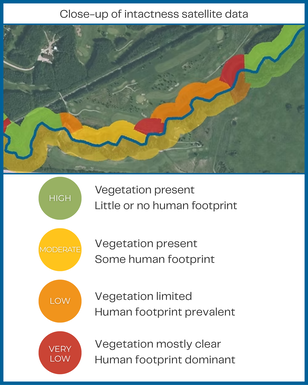
Ribbons of Green and the Riparian Web Portal
Riparian areas are often referred to as “ribbons of green,” for the way they surround rivers, wetlands, and lakes in water-loving, green vegetation. These zones hug the shoreline of meandering rivers, providing a refuge from development. These riparian “buffer” anchors the soil, influences groundwater filtration, prevents pollution, and provides habitat for a host of species. But these areas, and the ecosystem services they provide, are also threatened by invasive species, shoreline development, livestock, and pollution. NSWA’s Riparian Health Action Plan, and the Riparian Web Portal provide opportunities to tackle these issues. And luckily, there are a variety of on-the-ground initiatives working to conserve, protect and restore these essential green zones in the NSR watershed and across the province. The Riparian Web Portal highlights these efforts, while also inspiring others to take up the cause, and providing the tools and connections needed to get started.
In addition to showcasing environmental projects, the Riparian Web Portal also hosts a repository of riparian intactness data for watersheds across the province. This data helps align on-the-ground work with vulnerable areas, giving decision-makers an idea of where help is needed most.
The 2025 Contest Winners!
This year’s projects ranged from cattle exclusion fencing, off-site watering, bank stabilization, eco-engineering, and wetland restoration. With such a diverse representation of riparian projects, this year’s contest was tight. The two winning teams showcased exemplary efforts in environmental conservation and communication, from both the students and the coordinators.
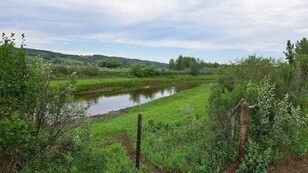
Winning Team #1: Conner Coleman, Garrett Gensler & Trinity Long with project coordinator, Sarah Skinner, Battle River Watershed Alliance (BRWA). Battle River Riparian Care Landowner Project
The BRWA came to the rescue when an agricultural producer grew concerned about the impact of cattle on the river and a nearby wetland. Covering 14 acres of riparian area, this project saw installation of cattle-exclusion fencing and two solar-powered off-site watering stations. The outcome was a win-win for the producer and for riparian health!
Project coordinator, Sarah Skinner, discussed working with her student team, saying, "they bring a fresh set of eyes to a project, ask great questions, and share their knowledge and perspectives."

Winning Team #2: Emma Branicki & Kamen Korejbo with project coordinator, Nick Boulton, Leaf Ninjas Inc. Whispering Pines Clinton Indian Band Streambank Restoration Project.
Leaf Ninjas aided the Whispering Pines Clinton Indian Band in a streambank restoration project on the North Thompson River, near Kamloops, B.C. With the addition of fencing and live willow staking, the area saw reduced erosion and flooding risk, helping restore the ecosystem and build the community's future environmental resilience!
The Thompson River project is the portal's first outside of Alberta! We asked coordinator, Nick Boulton, a bit more about it.
“Leaf Ninjas was excited about the opportunity to work, from the project onset, with not only the Band, but also work closely with the engineering firm Urban Systems and the Earthworks / Civil contractor Acres. This allowed all teams the opportunity to discuss the project details, the execution of the project throughout its many phases and to come together on a significant bioengineering scope. This project was really a culmination of the decade of experience for Leaf Ninjas in environmental restoration and to see if succeed in a big way makes our team very proud.”
For Nick, joining the contest was a great way to engage with youth in the environmental field. “The reality of working in restoration is that we are super specialized in our offerings and our experience and having the chance to connect with students who will soon be joining the workforce is a great motivator to engage with them. We have a Foreman on staff at Leaf Ninjas that came through Lakeland's program and he was also a huge supporter of working with students and to join the contest. Thank you for the opportunity to showcase our work and we look forward to the next one!”
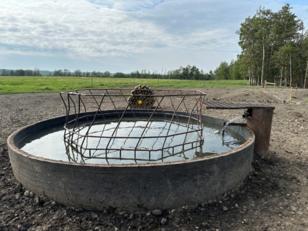
More Exciting Projects
ALUS – Wetaskiwin Leduc with Project Coordinator, Kim Barkwell: Off-site Watering System for Cattle to Conserve a Wetland
Students: Alia O’Neill & Olivia Malowany
The project site is located on pastureland used for cattle. Before project implementation, a drilled well with gas generator was used to pump water into a trough next to a permanent wetland. Livestock disturbance and over-filling the trough were a few issues that affected the overall health of the site. The farmer wanted to find a solution that was economical and beneficial to the wetland site. The farmer teamed up with ALUS in 2023 to enhance the wetland and provide a better watering system for his livestock.
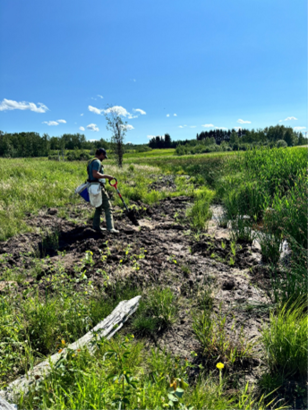
Parkland County with Project Coordinator, Jasper O'Driscoll: Edinburgh Park Wetland Replacement
Students: Caitlyn McLean and Nicholas Poirier
Student description: This project takes place on public land in Edinburgh Park, near the town of Duffield, AB. Beginning in winter of 2022, work included tuft and mound excavation to simulate variable topography, addition of large woody debris, planting of native trees and shrubs, reshaping of drainage ditches, and the creation of a natural spillway. Project partners included Parkland County, Alberta Environment and Parks, Associated Environmental, Earthworks Contracts, and K&S Growers.
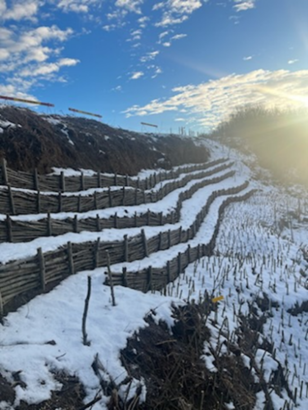
Town of Vegreville with Project Coordinator, Brianne Giles: Riverside Cemetery Bankside Stabilization project
Students: Emily Jarema, Hannah Lahey, and Sylvian Oak
Student description: The rapid erosion of the cemetery bank was a major concern. Beyond the immediate threat to the cemetery, the erosion had negative environmental impacts: Sediment runoff degraded the water quality of Vermilion River, and loss of stable bank habitat impacted local ecosystems. Traditional hard engineering solutions (like concrete walls) can be costly and less environmentally friendly. A sustainable and cost-effective approach was chosen - bioengineering. This involved using live vegetation to stabilize soil naturally. Project coordinator, Brianne Giles, Town of Vegreville partnered with Kristen Andersen, Associated Environmental to develop a solution.
NSWA also featured this project in a blog last year, after sitting down with Kristen Andersen to learn more. Read it here.
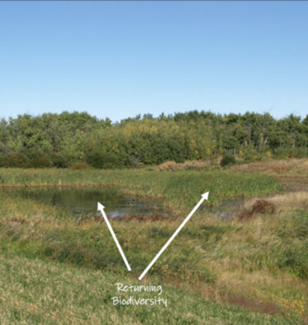
Hardway Ranch Wetland Restoration Project, with coordinator, Connor Layton. Riverside Cemetery Bankside Stabilization project
Students: Chelsea Hinton and Kesstyn Lambert
Student description: The 21-acre site's peatlands had been drained and restored throughout the 1900s. In 2012, the Hardway Ranch launched a restoration project to restore wetland function, enhance the ecosystem, and provide a sustainable water source for livestock. Rotational grazing with electric fencing was implemented to manage cattle access efficiently. Ducks Unlimited and AWES assisted in restoration, installing ditch plugs, erosion control measures, and seeding. Saplings were also planted. Ducks Unlimited advised that full ecological restoration would take 10 years from the start of dirt work. The project is set for completion in January 2031.
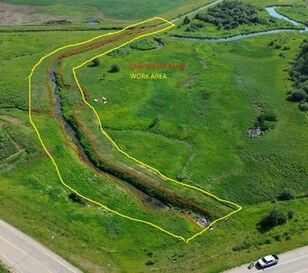
Alberta Agriculture and Irrigation with coordinator, Dennis Johnson. Alix Canal Confluence Restoration.
Students: Chelsea Hinton and Kesstyn Lambert
Student description: This project, led by Dennis Johnson from Alberta's Agriculture and Irrigation sector with the Government of Alberta, aimed to restore a degraded spillgate waterway in Alix, Alberta, within Lacombe County. The restored area spanned 680m (2.41 acres) from Alix Lake to its confluence with Parlby Creek. Its purpose was to mitigate hazards, such as new water passage formation and oxbow lake creation, which could alter water flow and harm properties. Key objectives included removing hydrophytic vegetation, restructuring stream flow, and rebuilding stream banks using clay layers, riprap, and native vegetation reseeding. Restoration occurred on public lands from March to July 2024, with consultations involving nearby homeowners. Outcomes of the project are expected to enhance stream conditions, facilitate riparian habitat restoration, and stabilize stream banks to protect the area's environmental and residential interests.